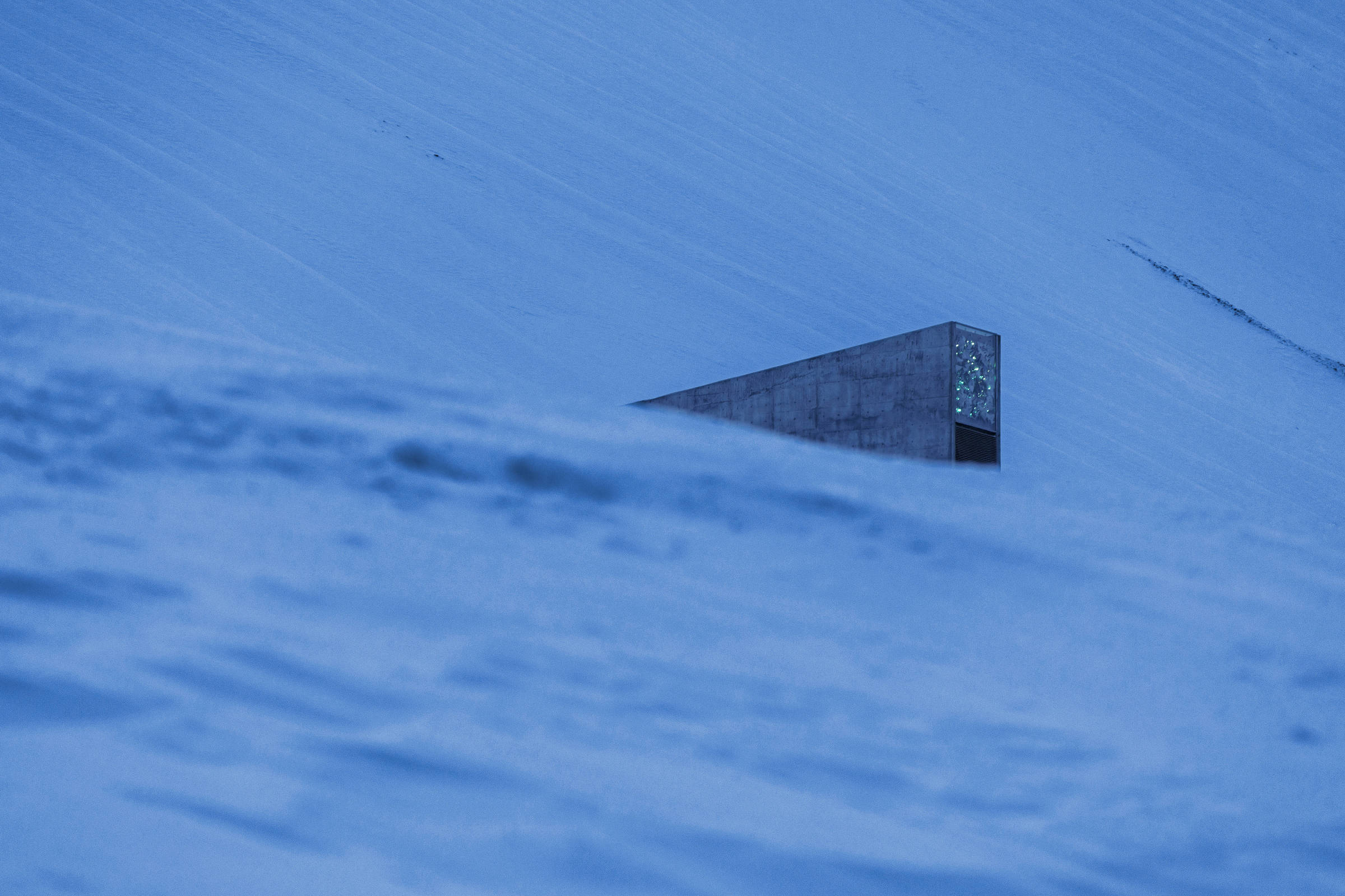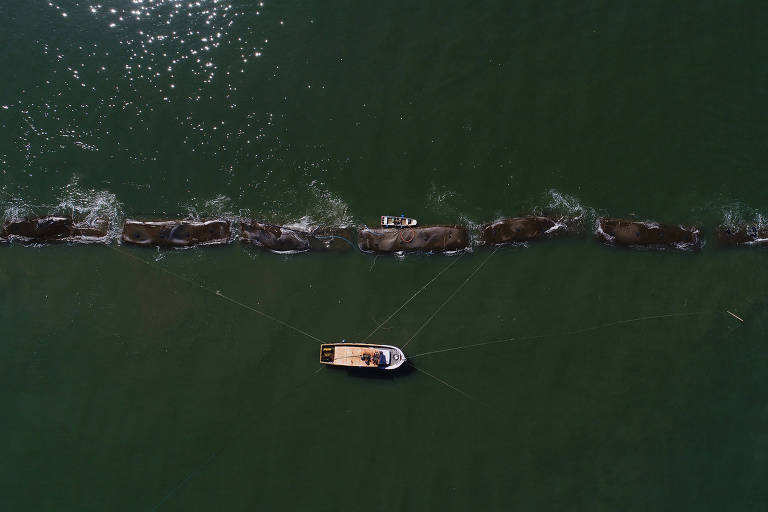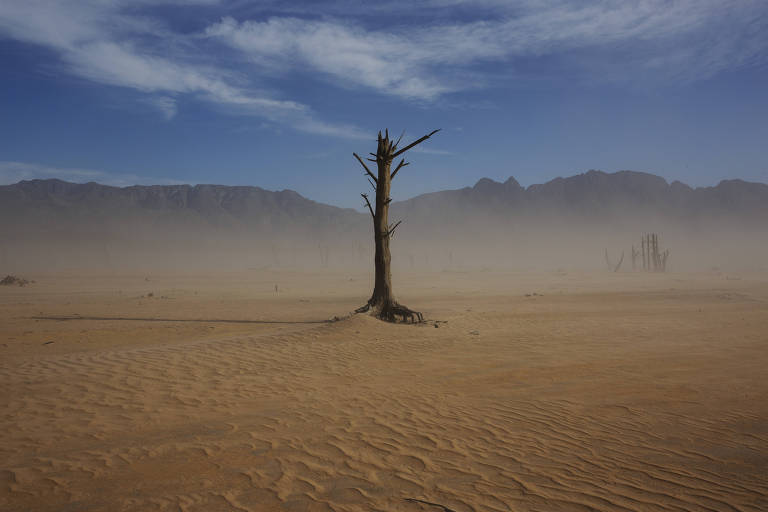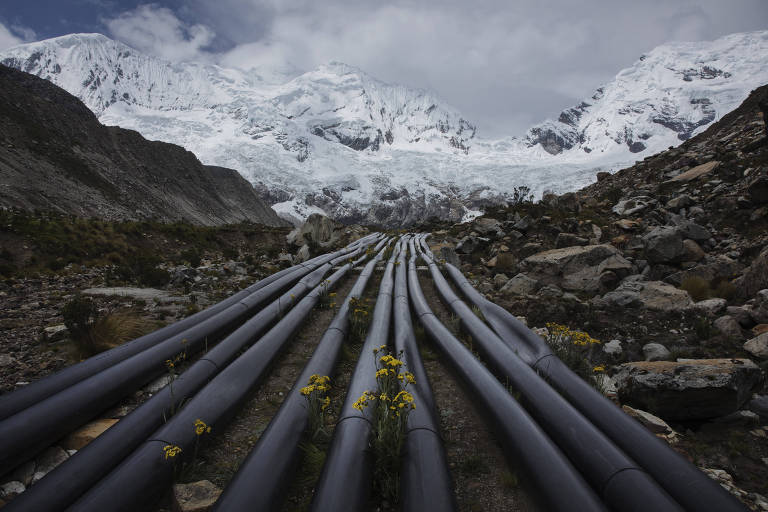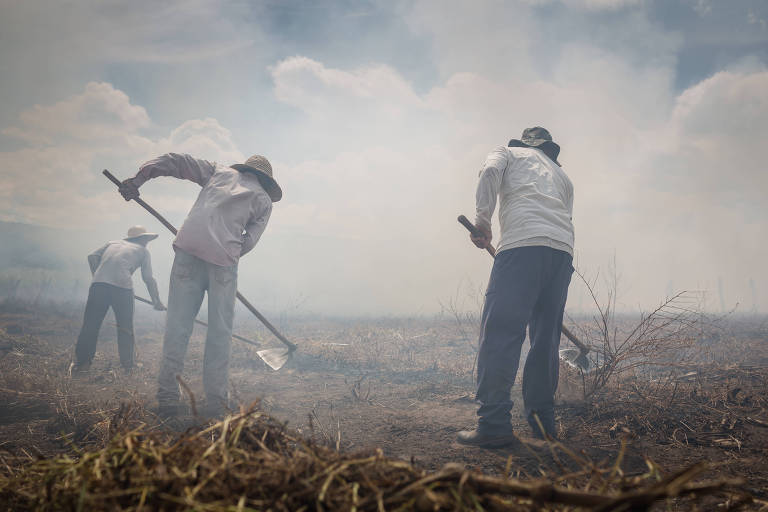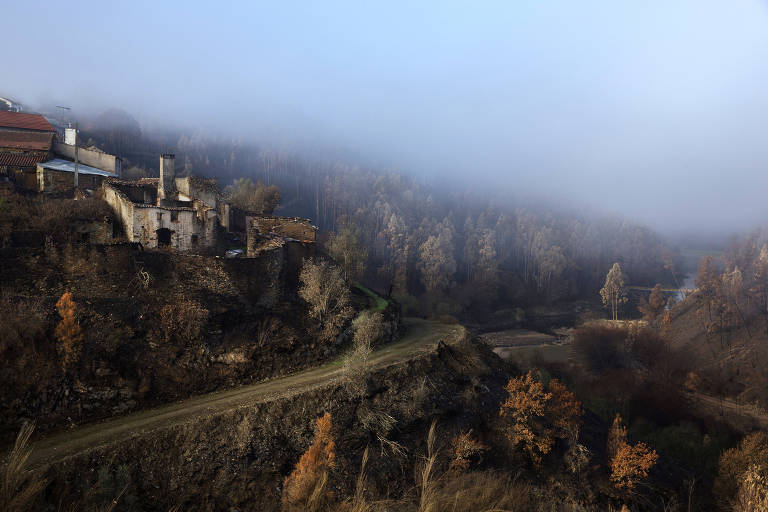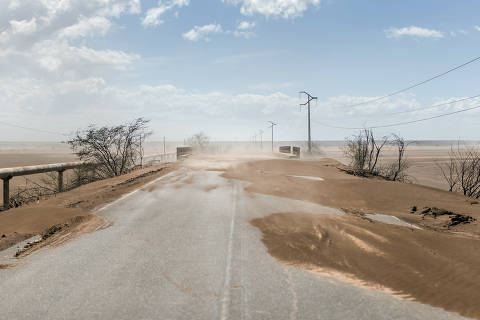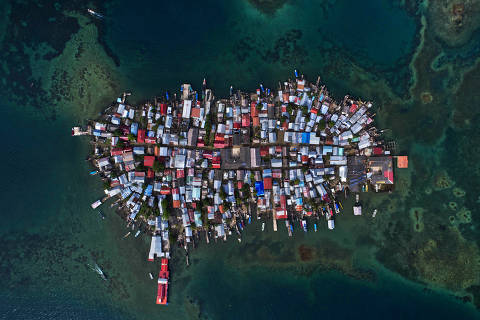Global Seed Vault undergoing renovation and repairs due to Arctic warming
1.mai.2018 - 02h00
{{video=1}}
{{lang=1|por,//arte.folha.uol.com.br/ciencia/2018/crise-do-clima/artico/|esp,//staging.arte.folha.com.br/ciencia/2018/crisis-del-clima/artico/}}
Cold and wind punished the slope of Plateau Mountain (Platåberget, in Norwegian), across from the Longyearbyen airport. Members of the Store Norske men's chorus endured the weather stoically in their blue jumpsuits and white, military-style hats.
They sang Norwegian folk songs under the falling rain –a surprise addition to the ceremony commemorating the tenth anniversary of the Global Seed Vault.
Norway's Minister of Agriculture, Jon Georg Dale, accompanied by two dozen journalists and as many seed donors, looked on in now-soaked clothing. Still in the middle of the Arctic winter, attendees were dressed for snow, not rain.
{{imagem=1}}
Both the seed bank and the airport are 5 km (3 miles) from downtown Longyearbyen, the northern-most city on the planet. The temperature usually hovers around -15°C (5 degrees Fahrenheit) this time of year, yet February 26th was a comparatively balmy 3°C (37 degrees Fahrenheit) and far from the norm for the 78th parallel north, a mere 1,300 km (about 800 miles) from the North Pole.
About 2,000 people make their home in the capital city of the Svalbard archipelago, where tourists shell out about $175 per night to see the aurora borealis, ride snowmobiles and observe polar bears threatened by global warming –provided they carry a firearm with them, in case an animal is hungry and attacks.
It rained again the following day. Some left Svalbard without ever seeing the Northern Lights. Water froze on the sidewalks and streets, leaving many tourists confined to their hotels.
Folha de S.Paulo had planned a lengthy road trip that very day to visit glaciers in retreat due to climate change, but the team had to settle for views of puddles –and more rain –in the streets of Longyearbyen and on the roads leading to nearby coal mines.
{{video=6}}
The next morning it was possible to reach Lonyearbreen, a small glacier perched atop a valley overlooking the city. Two stakes hammered into the snow marked the entrance to an ice cavern that has grown in size with each summer's melt-off.
After a bit of digging, our guide, Francisco "Chicco" Mattos, located the ladder leading down into the cave. A Brazilian with a passion for the Arctic, Mattos has lived in Longyearbyen for seven years, where he makes a living doing documentary production work. At first, the frozen crevice resembled an animal's burrow, but it soon opened into a vaulted basilica of compressed ice, marbled with bits of rock that had been pulverized over centuries –or millennia.
{{imagem=2}}
It was an atypical week in the Arctic. Temperatures in this region are warming faster than anywhere else on the planet, rising at least 4°C (7.2 degrees Fahrenheit) in recent decades, compared to a 1°C (1.8 degree Fahrenheit) rise for the rest of the planet. At the end of February, however, meteorological conditions moved into uncharted territory.
The Morris Jesup weather station in northern Greenland, one of the closest outposts to the North Pole, registered more than 60 hours of above-freezing temperatures. Satellite instruments measured temperatures at 20°C (36 degrees Fahrenheit) above average for the Arctic as a whole. In the Svalbard archipelago, average temperatures were 11°C (20 degrees Fahrenheit) above normal for the time of year.
It was certainly not the first time weather changes had frustrated humans in the city founded by American John Munro Longyear in 1906 –though the coal miners of the era would have worried more about dodging snow and avalanches than prising open car doors iced shut by freezing rain.
{{mosaico=1}}
Arctic climate change has placed some bumps in the road for the Global Seed Vault, a $9 million project inaugurated a decade ago by the Norwegian government to act as a safeguard against the effects of climate change –or other disasters that could impact global agricultural diversity.
1,059,646 individual seed samples are presently stored at the site, with the last 76,000 deposited on February 26, the Vault's ten-year anniversary. Seed duplicates are housed in 73 donor banks around the world, including with Cenargen, a branch of Embrapa, the state-funded agricultural research corporation linked to Brazil's Ministry of Agriculture.
"There are natural disasters, such as the tsunami that destroyed a genetic seed bank in the Philippines," explains Marie Haga, executive director of the Global Crop Diversity Trust, which oversees and administers the Seed Vault. "We have also lost gene banks in Afghanistan and Iraq. It's comforting to know that if things go wrong, we can go to Svalbard, get the seeds back and start all over again."
{{video=3}}
In Aleppo, an important seed collection assembled by the International Center for Agricultural Research in the Dry Areas (ICARDA) was rendered inviable by Syria's ongoing civil war. With 92,430 duplicate seeds from Svalbard, ICARDA was able to reconstitute the collection in Lebanon and Morocco in 2015. Only the organization that initially deposited the seeds can remove samples from the frozen seed bank.
"The most fundamental problem of agriculture today is that the seeds that feed us cannot adapt as fast as the changing climate," Haga explains.
"Plants and humanity have adapted over time, but this has taken tens of thousands of years. We need to crossbreed plants that can withstand higher temperatures, tolerate higher salinity in the soil and fight new pests and diseases. Agricultural genetic diversity is the raw material that informs our work."
One example of what can be achieved by crossing strains is soybeans. In Brazil, soy has been acclimated by Embrapa for cultivation in the tropical savanna known as the cerrado, and even in the equatorial Amazon.
{{info=1}}
A single commercial variety of wheat such as Veery, for example, is the product of 3,170 crosses with 51 parent plants from 26 countries.
14 years ago, the idea of building an Arctic stronghold with the goal of preserving agricultural diversity for the future was considered bizarre by many –and potentially embarrassing for the Norwegian government– recounts Cary Fowler, the founding director of Crop Trust.
When Fowler first presented the proposal to Norway's foreign minister in Oslo, a young high-ranking official responded: "Dr. Fowler, are you saying that this is the Earth's most important resource? And that Svalbard would be the best place on the planet to safeguard it? How can we say no to that?"
Svalbard may be the ideal locale to store this treasure, but it is not immune to global warming. The seed storage temperature is maintained at -18°C (just under zero degrees Fahrenheit), and it helps that the vault is housed inside a mountain where thermometers barely move between -3 to -4°C (roughly 25 to 27 degrees Fahrenheit), even during the summer.
{{imagem=5}}
{{imagem=16}}
Walking along a nearly 400-foot tunnel that slopes gradually downward to reach the seed vault, the ambient temperature seemed warmer than the air outside. This was partially due to the absence of wind inside the mountain, but also because it was a particularly cold day when the Folha team visited on February 25th.
During a typical year, the vault is opened just three or four times when there are seeds to deposit. For the ten-year commemoration, however, it was opened more than a dozen times, mostly to welcome visiting news organizations. Groups enter one at a time, accompanied representatives of the Nordic Genetic Resource Centre (NordGen), the custodian of the vault.
Photography is prohibited inside the tunnel for security reasons, and there was some construction work underway. The permafrost ground layer that envelops the iconic triangular stronghold on the slopes of Platåberget Mountain has not refrozen as expected in recent years because of warmer than average temperatures.
The prospect of melting permafrost is disconcerting for property owners in Longyearbyen, whose homes are at risk of sinking. However, the Seed Vault's three climate-controlled vaults –each with a capacity of 1.5 million genetic seed samples– remain safe, surrounded by a solid stone mass.
{{video=2}}
In recent years, the seed vault's main tunnel experienced some flooding due to permafrost melt. The facility is presently undergoing improvements to make it more waterproof. The Norwegian government is spending $13 million on the renovations, more than its entire initial investment in the project.
The tunnel is being reinforced with concrete and will contain new enclosures to house electrical and refrigeration equipment capable of maintaining the temperature, even in the event of a power outage. Vault workers say that the seeds themselves have never been at risk.
The tunnel opens into a large, 20-foot high atrium dubbed "the cathedral", a concrete-lined space in which three individual seed vaults are housed. Double doors made of metal protect the entrance of each vault. For now, only the middle one is active, its entrance encrusted with ice crystals.
It took two years for the target temperature to be stabilized. Diesel compressors ensure the cooling of the rock layer around the vault so that there are no fluctuations to the constant -18ºC temperature. Reporting teams were only allowed ten minutes inside the chamber in order to prevent body heat from disturbing the environment.
{{mosaico=2}}
Inside the main vault, there are six rows of steel shelves from floor to ceiling, filled with large plastic containers. Inside the recepticles, seeds are packed in thick aluminum foil packets and vacuum sealed with five percent internal humidity. When maintained under these conditions, seeds can germinate up to a century after being stored.
The creators of the seed bank argue that situating it in Svalbard was a sound choice, and maintain that the island of Spitsbergen remains the best place for the Vault. "Global warming and its effect on permafrost is a major irritation," says Fowler, "but not a true threat [to the seeds]."
"No matter where you go on the planet to store seeds," Fowler continues, "you will always need to lower the temperature that nature offers you. There is no place on Earth you can easily access that will give you a constant temperature of -18°C."
"We will still have temperatures of -4ºC (25 degrees Fahrenheit) inside the mountain for several hundred years," observes Marie Haga, of Crop Trust. "And there are other advantages. Politically, it is a very stable part of the world, and there are no earthquakes or volcanoes. The community of Longyearbyen is the Global Seed Vault's caretaker. If anyone in the city has bad intentions, word will travel fast."
{{imagem=10}}
"I look at glaciers I've known for 30 years and they've changed more than my wife has," laments meteorologist Kim Holmén, international director of the Norwegian Polar Institute. He's lived in Longyearbyen for nine years and has been researching Svalbard for the past three decades. When it comes to the transformation of the Artic, Holmén does not mince words:
"Wherever I look I see obvious changes. The fjord outside the window isn't covered with ice. The ice used to be one meter thick this time of year [in February]; now, it's open water. The snow disappears two weeks earlier in the spring."
{{info=2}}
"Glacier thickness is shrinking at a rate of up to 40 cm (nearly 16 inches) per year," he continues. "Average nighttime temperatures in winter have risen 10ºC (18 degrees Fahrenheit) over the past 30 years. And while summer temperatures haven't risen that much, this is consistent with our estimates for human-induced climate change. The list is endless."
Changes to the local fauna and ecosystem are occurring at a remarkable pace, and it is not just polar bears struggling on the melting sea ice they use as a platform to ambush seals.
Little auks (a type of arctic bird) have been forced to fly further north in search of copepods (small crustaceans) with greater fat stores. Polar cod are seeking out cooler waters and ice sheets under which to lay their eggs. Mackerel and other warm-water fish have been invading the archipelago, which in turn attract new species of birds –such as the northern gannet– to the area.
{{mosaico=4}}
{{imagem=11}}
"The polar bear is a symbol for the entire ecosystem, but the polar cod are part of it as well, just like the beluga whale, narwhals and other species that depend on sea ice," says Holmén. "There are few of us privileged enough to see polar bears in their natural habitat. Most people believe the world will be a lot poorer if the polar bear disappears altogether."
Some of these people, if they have the resources –and the courage to confront the cold– visit Svalbard in the hope of observing the threatened bear. They drive around the island of Spitsbergen in diesel-powered cars and gas-guzzling snowmobiles.
Along the airport road, the thermoelectric power plant consumes fossil fuel from coal to heat hotels and restaurants, releasing greenhouse gases into the atmosphere while powering the generators that keep the Seed Vault at a constant -18ºC.
{{imagem=15}}
Norway finances the Global Seed Vault, and has allocated $1 billion to the Amazon Fund for projects seeking to alleviate pressure on the Brazilian rainforest. The Norwegian government also offers tax incentives in an effort to make its fleet of cars fully electric. The country still derives nearly all of its wealth from oil and natural gas, however, which it produces and exports from the North Sea.
"As a fossil fuel-producing nation, we have to transform our economy, knowing that the viability of the oil and gas industry will be reduced in the future," said Ola Elvestuen, Norway's Minister of Climate and Environment.
"This is not something that we can just turn off like a light switch," she adds. "We need to be at the forefront of reducing emissions and take responsibility for diversifying our economy."
"The industry is part of the solution, not the enemy," observes Holmén of the Norwegian Polar Institute. "You and I are part of the problem, you and I are part of the solution. If we do not start manufacturing and consuming products that require less petroleum, nothing will change.
{{imagem=6}}
